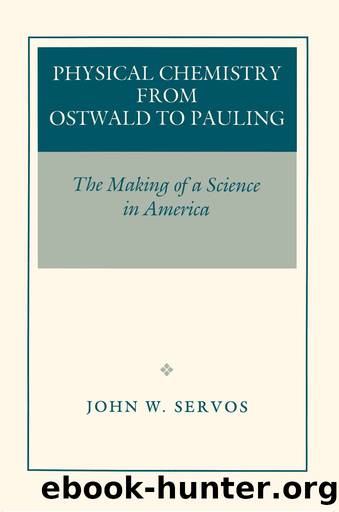Physical Chemistry from Ostwald to Pauling by John W. Servos

Author:John W. Servos [Servos, John W.]
Language: eng
Format: epub
Tags: Science, Chemistry, Physical & Theoretical
ISBN: 9780691085661
Google: KxWzQgAACAAJ
Publisher: Princeton University Press
Published: 1990-01-15T01:13:48+00:00
CHAPTER 5
Physical Chemistry in the âNew World of Scienceâ
THE PROSPECTS facing physical chemists at the beginning of the twentieth century were exhilarating. The conceptual breakthroughs made by vanât Hoff and Arrhenius in the 1880s had been the prelude to a wave of new ideas and discoveries in the region between chemistry and physics. Some, such as Nernstâs theory of electromotive force or his later heat theorem, were made by workers within the research tradition of the Ionists. Others, such as the discovery of the electron, radioactivity, the radioactive-decay series, and the diffraction of X-rays by crystals, were made by scientists who, like J. J. Thomson, Henri Becquerel, Ernest Rutherford, Frederick Soddy, and Max von Laue, emerged from different intellectual traditions. But whatever their backgrounds, the paths of these scientists seemed to converge in the broad region between chemistry and physics. Soddy was known as a physical chemist, as was Rutherford during the early portion of his career. Thomsonâs works were read as avidly by physical chemists like Noyes and Lewis as by physicists. And X-ray diffraction, although discovered in a physics institute, was applied by both physical chemists and physicists. As is often the case when knowledge expands rapidly, boundaries were mobile, but physical chemistry seemed to have as strong a claim to the strategic crossroads of modern science as any other discipline.
The freedom to traverse the borderlands between chemistry and physics, the excitement that came with being present at the beginnings of a new discipline, the possibility of making fundamental discoveriesâa possibility made all the more real by the recent history of such breakthroughsâall this contributed to making physical chemistry a deeply satisfying discipline for its devotees. Satisfying too, especially in a country so sparsely dotted with facilities for scientific research as America, was the construction of institutions where none had existed before. The process typically was slow; Ostwaldâs American pupils had to serve the needs of their departments and universities before the needs of their discipline and this usually meant heavy teaching responsibilities in subjects like analytical chemistry. But as they gained seniority, and as the universities in which they worked grew in size and wealth, physical chemists often could shed duties extraneous to their interests and concentrate on their own subject.
By 1905 or 1910 the results were becoming apparent. American laboratories were beginning to produce important papers, most of those papers were being published in American journals, and the great majority of young physical chemists were taking their graduate degrees at home rather than abroad. Foreign students were beginning to study physical chemistry at American universities, and even the founders and leaders of the discipline, vanât Hoff, Ostwald, Arrhenius, and Nernst, were finding it worthwhile to cross the ocean and lecture in America. At the International Congress of Arts and Sciences, a scholarly extravaganza held in conjunction with the St. Louis Worldâs Fair of 1904, physical chemists, both American and European, held an important place on the program.1
Despite the satisfactions of a career in physical chemistry and
Download
This site does not store any files on its server. We only index and link to content provided by other sites. Please contact the content providers to delete copyright contents if any and email us, we'll remove relevant links or contents immediately.
Alchemy and Alchemists by C. J. S. Thompson(3297)
The Elements by Theodore Gray(2852)
The Club by A.L. Brooks(2747)
How to Make Your Own Soap by Sally Hornsey(2742)
Drugs Unlimited by Mike Power(2485)
Wheels of Life by Anodea Judith(1919)
Cracking the Sat French Subject Test, 2013-2014 Edition by The Princeton Review(1767)
Perfume by Jean-Claude Ellena(1739)
The Flavor Matrix by James Briscione(1714)
The Cosmic Machine: The Science That Runs Our Universe and the Story Behind It by Scott Bembenek(1693)
Cracking the LSAT, 2012 Edition by Princeton Review(1692)
MCAT Physics and Math Review by Princeton Review(1568)
1000 Multiple-Choice Questions in Organic Chemistry by Organic Chemistry Academy(1566)
The Thing Around Your Neck by Chimamanda Ngozi Adichie(1481)
Cracking the SAT Premium Edition with 6 Practice Tests, 2017 by Princeton Review(1480)
Handbook of Modern Sensors by Jacob Fraden(1477)
A is for Arsenic: The Poisons of Agatha Christie (Bloomsbury Sigma) by Kathryn Harkup(1455)
Synchrotron Light Sources and Free-Electron Lasers by Eberhard J. Jaeschke Shaukat Khan Jochen R. Schneider & Jerome B. Hastings(1454)
Harry Potter All Books: 8 Books by J.k.rowling(1436)
